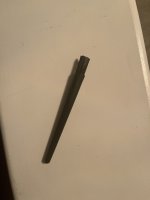gatewayrepairs1985
Experienced Member
I will keep this in mind and report back. Thank you for all the advice....also don't forget this remark I made about doing it; "Saturate the area with CRC's CO contact cleaner and brush between the pins".
It is not a good idea to brush dry IC pins. When it is saturated with the cleaner it prevents and electrostatic charges building up. Though it is much more risky to dry brush IC pins out of circuit than in/on a circuit board, because normally, in circuit, there are no floating input pins.
How does this brush look?

